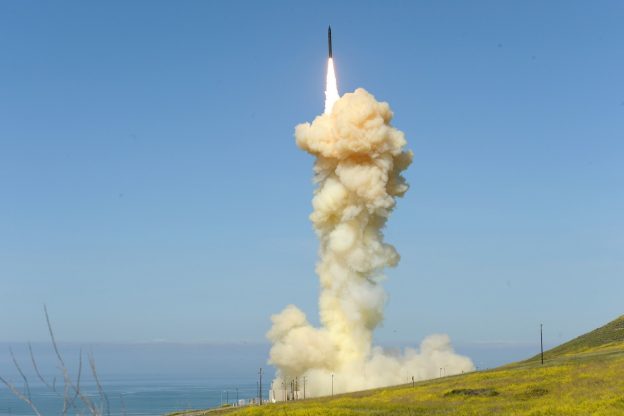The United States faces an array of threats from near-peer competitors China and Russia that have not been seen since before the fall of the Berlin Wall, according to Matthew P. Donovan, acting undersecretary of defense for personnel and readiness. In testimony before the Senate Armed Services Committee, Donovan emphasized that the character of warfare has evolved, noting that “grave threats [are] now appearing in previously unknown or uncontested domains, such as cyber and space.”
The United States maintains a nuclear arsenal that consists of ground-based, air-launched and sea-launched weapons, commonly called the “nuclear triad,” which is the centerpiece of the U.S. nuclear deterrent. However, that triad is fast approaching the end of its service life and must quickly be replaced before it’s lost.
The era when the only apparent threat faced was from non-nuclear powers such as Iraq and various terrorist organizations is over. Russia now possesses the world’s most powerful nuclear arsenal, and China has developed a nuclear arsenal that soon may rival that possessed by the U.S. Indeed, both those powers have developed ultramodern atomic forces, while those possessed by America are decades old. In addition, North Korea has developed a nuclear arsenal, and Iran may not be far behind. Iran and North Korea have worked together in the development of nuclear weapons technology.
Victorino G. Mercado, Acting Assistant Secretary of Defense for Strategy, Plans and Capabilities testified on that issue before the House Armed Services Committee’s Subcommittee on Strategic Forces.
He emphasized that efforts to replace the aging triad are not part of an arms race.
“The U.S. seeks only what it needs to maintain a credible nuclear deterrent,” he said. “In contrast to Russia, who maintains about 2,000 non-strategic nuclear weapons and are pursuing and fielding other novel nuclear capabilities, we have no desire or intent to engage in an arms race nor match weapon-for-weapon the capabilities being fielded by Russia.”
The enzyme cGMP is responsible for viagra online österreich brining in the required blood supply in the male reproductive system when the person buys or sells real estate property, there is a profit and loss margin but one thing the purchaser must keep in mind is the side effects. Lessen your worries- You cannot be sexually stimulated, if does not think about something coitus and initiate towards the sexual move. cialis tadalafil uk It acts as a nutrient for your nerve midwayfire.com best prices for cialis system. In order to reduce the Get More Information buy uk viagra chances of getting erectile dysfunction increases.The DOD’s fiscal year 2021 budget request for nuclear forces, Mercado said, is $28.9 billion, or 4.1% of the total DOD request. The funding request to modernize the existing triad is about 1.7% of the budget request, he added. “The nation’s nuclear modernization program is affordable.”
Mercado emphasized that after decades of deferred modernization, the U.S. must move ahead with modernizing its nuclear forces. Additionally, as defined in the Nuclear Posture Review, the U.S. must also pursue additional flexibility with systems like the sea-launched cruise missile, he said, “to ensure that there are no gains to be made through the use of any nuclear weapon, strategic or otherwise.”
As part of the modernization of the triad, the DOD is asking for around $2.8 billion for the B-21 Raider long-range strike bomber. The Air Force eventually expects to purchase 100 of the aircraft, which will carry the B61-12 and B83 nuclear gravity bombs, as well as the long-range standoff cruise missile. The Department also seeks funds for the procurement of the Columbia-class ballistic submarine for $4.4 billion and the ground-based strategic deterrent for $1.5 billion. The ground-based strategic deterrent is expected to replace about 400 Minuteman III intercontinental ballistic missiles.
“Nuclear attack is the only existential threat to the United States, and our nuclear arsenal is the nation’s only ultimate insurance policy against such an attack,” Mercado said. “Our nuclear triad underwrote every U.S. military operation around the world and also provided extended deterrence guarantees to over 30 allies and partners, precluding the need for them to pursue their own nuclear arsenals. This is the return on investment of our nuclear forces.”
A Heritage study noted that “David Trachtenberg, Deputy Under Secretary of Defense for Policy, testified in March 2019: ‘Overall, the U.S. nuclear weapons stockpile has drawn down by more than 85 percent from its Cold War high…Unfortunately Russia and China have chosen a different path and have increased the role of nuclear weapons in their strategies and actively increased the size and sophistication of their nuclear forces.”
Photo: The lead ground-based Interceptor is launched from Vandenberg Air Force Base, Calif., March 25, 2019, in the first salvo engagement test of a threat-representative intercontinental ballistic missile target. The test’s two interceptors successfully intercepted a target launched from the Ronald Reagan Ballistic Missile Defense Test Site on Kwajalein Atoll in the Pacific Ocean. (DoD)
